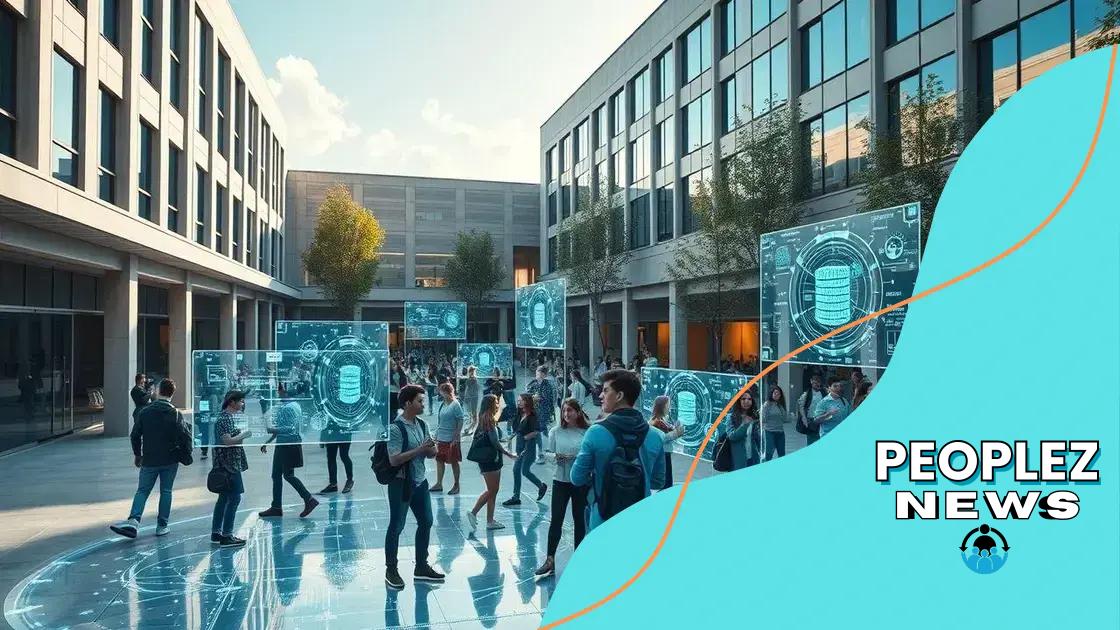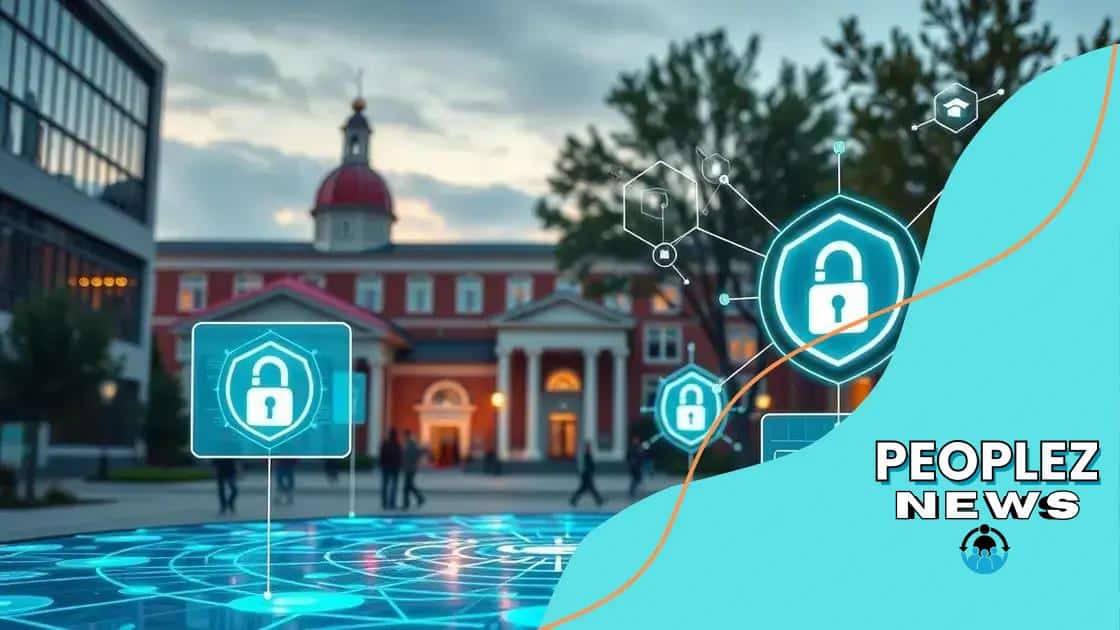Blockchain technology for academic credentialing: a game changer

Blockchain technology for academic credentialing enhances security, efficiency, and trust in educational records, enabling real-time verification and greater accessibility for students and institutions alike.
Blockchain technology for academic credentialing is emerging as a powerful solution, revolutionizing how we validate educational achievements. Have you ever wondered how this innovation could impact your academic future?
Understanding blockchain technology
Understanding blockchain technology is crucial to grasp how this innovation transforms various sectors, particularly education. It offers a decentralized system where transactions are secure, transparent, and immutable.
The primary feature of blockchain is its ability to maintain a digital ledger shared across multiple computers. This ensures that all participants have access to the same information, reducing the chances of fraud. Now, let’s delve deeper into its functionalities.
Core Components of Blockchain
Blockchain is made up of several key components:
- Blocks: Each block contains data and a unique hash.
- Chain: Blocks are linked in chronological order.
- Nodes: These are the computers that validate and store copies of the blockchain.
- Consensus Mechanisms: Ensures all nodes agree on the current state of the blockchain.
This combination creates a robust security framework. Each transaction is recorded across a network, making it nearly impossible to alter past entries without detection. Understanding these components is the first step to embracing the potential of blockchain technology for academic credentialing.
The Role of Cryptography
Cryptography is a backbone of blockchain technology. It secures data and ensures that transactions are valid. When users send information, it’s encrypted, meaning only authorized parties can access it. This feature is particularly important in academia, as credentials must be protected from unauthorized access.
Additionally, smart contracts enhance blockchain’s functionality by automating agreements. These self-executing contracts ensure that once conditions are met, actions are automatically completed without human intervention, streamlining processes in educational institutions.
By understanding how blockchain technology works, stakeholders can leverage its benefits, ensuring trustworthiness and efficiency in academic credentialing practices. The technology is set to redefine how we manage and verify credentials, making systems more reliable.
How blockchain enhances credential verification
How blockchain enhances credential verification is a key topic in understanding its impact on education. Traditional systems often struggle with fraud and inefficiency, but blockchain provides a solution that is both effective and innovative.
By using a decentralized approach, blockchain enables institutions to store and verify credentials securely. Each credential is recorded as a unique block on the blockchain, making it tamper-proof. This means that once a credential is issued, it cannot be changed or forged.
Key Benefits of Blockchain in Credential Verification
There are several important advantages:
- Increased security: Since data is encrypted and distributed, the risk of unauthorized access is significantly reduced.
- Improved transparency: All transactions can be viewed by authorized parties, allowing for easy verification.
- Faster verification processes: Institutions can instantly verify credentials, reducing waiting times.
- Lower costs: Reducing manual processes and paperwork can lead to significant savings.
Furthermore, blockchain reduces the administrative burden on educational institutions. Instead of manually verifying documents, schools can quickly access the blockchain ledger. This not only saves time but also allows institutions to focus resources on more critical tasks, enhancing overall efficiency.
A key aspect is the use of smart contracts. These are automatic contracts that execute when predefined conditions are met. In education, this means that once a student graduates, their credentials are automatically updated on the blockchain. This seamless process drastically cuts down on administrative errors and delays.
Overall, embracing blockchain technology for credential verification means enhancing trust and efficiency in the educational field. As more institutions adopt this technology, verification will become easier and more reliable, paving the way for a more transparent educational landscape.
Benefits of using blockchain in education

Benefits of using blockchain in education are transforming how educational institutions operate. This innovative technology enhances processes and improves trust and security.
Schools and universities can benefit significantly by adopting blockchain systems. One of the main advantages is the improved security of student records. Traditional databases can be vulnerable to hacking, but blockchain’s decentralized structure ensures that data is kept safe and private.
Key Advantages of Blockchain in Education
Here are some of the key benefits:
- Data integrity: Information recorded on the blockchain cannot be altered, ensuring that student records remain accurate.
- Efficient management: Streamlined processes reduce the time needed to verify educational credentials.
- Cost-effectiveness: By minimizing paperwork and administrative costs, schools can allocate resources more effectively.
- Increased access: Blockchain allows students to share their credentials with employers directly, reducing the need for middlemen.
Implementing blockchain technology also fosters a culture of learning oriented towards integrity and accountability. By trusting the data recorded, both schools and employers can make better-informed decisions.
Moreover, blockchain enhances accessibility for students around the world. With a secure digital platform, individuals can access their credentials anytime and anywhere, supporting the global movement towards online education.
These benefits indicate how blockchain technology is not just a trend but a vital tool for evolving the education sector. As institutions strive to adapt to a more digital world, blockchain stands out as a solution that can bring about substantial positive change.
Challenges of implementing blockchain technology
Challenges of implementing blockchain technology in education should not be overlooked. Although it offers many benefits, several obstacles can hinder its adoption in academic institutions.
One major challenge is the lack of understanding of blockchain among educators and administrators. Without sufficient knowledge, it can be difficult to implement this complex technology effectively. Furthermore, training staff to use blockchain systems properly requires time and resources.
Key Challenges in Adoption
Here are some of the key issues faced:
- Interoperability: Different blockchain platforms may not work well together, making it hard to share data between systems.
- Regulatory compliance: Education institutions must ensure that blockchain implementations comply with local laws and regulations regarding data protection and privacy.
- High initial costs: Setting up blockchain technology can be expensive, which may deter institutions from adopting it.
- Resistance to change: Many people in education may be hesitant to adopt new technologies, preferring traditional methods over unfamiliar systems.
Additionally, there is a concern regarding the scalability of blockchain. As the number of users increases, maintaining the speed and efficiency of transactions can become challenging. Institutions must invest in infrastructure to handle the growing demands.
Despite these challenges, the potential of blockchain technology for improving processes in education remains significant. Continued efforts to educate stakeholders about its advantages and to develop more user-friendly systems are essential for its successful implementation.
The future of academic credentialing with blockchain
The future of academic credentialing with blockchain is promising, as this technology continues to evolve and reshape the educational landscape. By integrating blockchain, institutions can offer a more secure, reliable, and efficient way to manage academic records.
As more universities and colleges adopt blockchain, we may see a shift towards automated systems for issuing and verifying credentials. This technology enables real-time updates to student records, eliminating delays commonly associated with traditional methods. The benefits extend beyond just efficiency; they also include increased trust from employers and academic institutions.
Emerging Trends in Blockchain Credentialing
Several trends are taking shape:
- Decentralized education: Learning can become more accessible as blockchain allows for the verification of credentials across borders easily.
- Micro-credentials: Institutions may offer smaller, focused qualifications that can be stacked towards a degree, allowing for tailored educational paths.
- Partnerships with employers: Educational institutions may collaborate with employers to ensure that the skills taught align with industry needs.
- Interoperable systems: Future blockchain applications will likely focus on creating systems that allow different institutions to easily share and verify credentials.
Furthermore, students will gain more control over their own educational data. By managing their digital identities on the blockchain, they can share credentials with potential employers directly, reducing the risk of fraudulent claims.
The advancement of blockchain technology could lead to a more inclusive educational environment. Individuals in remote areas can access digital learning resources and have their achievements recognized universally.
Overall, the future of academic credentialing with blockchain looks bright. As the technology matures, we can expect it to foster greater innovation and transparency in education.
FAQ – Frequently Asked Questions about Blockchain in Academic Credentialing
How does blockchain enhance security in academic records?
Blockchain technology protects academic records from fraud by creating an immutable ledger that ensures data integrity.
What are micro-credentials and how are they related to blockchain?
Micro-credentials are small, skills-based qualifications that can be verified through blockchain, allowing more personalized education paths for students.
What challenges do educational institutions face when implementing blockchain?
Institutions face challenges like lack of knowledge, high initial costs, and the need for regulatory compliance when adopting blockchain technology.
What future opportunities does blockchain offer for education?
Blockchain offers opportunities such as decentralized education, real-time credential verification, and improved access for learners worldwide.





